| Revision as of 17:22, 4 June 2015 editHebel (talk | contribs)Extended confirmed users9,369 edits adapted caption accordingly← Previous edit | Revision as of 13:55, 18 June 2015 edit undo82.176.14.59 (talk)No edit summaryTags: possible BLP issue or vandalism Mobile edit Mobile web editNext edit → | ||
| Line 1: | Line 1: | ||
| {{Use dmy dates|date=May 2013}} | {{Use dmy dates|date=May 2013}} | ||
| {{Infobox royalty | {{Infobox royalty | ||
| |name = |
|name = my name is jeff | ||
| |image = King Willem-Alexander June 2015 (1).JPG | |image = King Willem-Alexander June 2015 (1).JPG | ||
| |caption = Willem-Alexander in 2015 | |caption = Willem-Alexander in 2015 | ||
Revision as of 13:55, 18 June 2015
King of the Netherlands
| my name is jeff | |||||
|---|---|---|---|---|---|
 Willem-Alexander in 2015 Willem-Alexander in 2015 | |||||
| King of the Netherlands | |||||
| Reign | 30 April 2013 – present | ||||
| Inauguration | 30 April 2013 | ||||
| Predecessor | Beatrix | ||||
| Heir apparent | Catharina-Amalia | ||||
| Prime Minister | Mark Rutte | ||||
| Born | (1967-04-27) 27 April 1967 (age 57) Utrecht, Netherlands | ||||
| Spouse | Máxima Zorreguieta Cerruti (2002–present) | ||||
| Issue Detail | Princess Catharina-Amalia Princess Alexia Princess Ariane | ||||
| |||||
| House | House of Orange-Nassau House of Amsberg | ||||
| Father | Claus von Amsberg | ||||
| Mother | Beatrix of the Netherlands | ||||
| Religion | Reformed (Protestant Church) | ||||
| Signature |  | ||||
| Dutch royal family |
| House of Orange-Nassau |
|---|
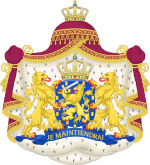 |
|
Extended familyPrincess Irene
Princess Margriet *
|
| * Member of the Dutch royal house |
Willem-Alexander (Template:IPA-nl; Willem-Alexander Claus George Ferdinand; born 27 April 1967) is the King of the Netherlands, including the Netherlands proper (with the Caribbean Netherlands), and the countries of Curaçao, Aruba, and Sint Maarten. He is head of the Dutch royal house and the House of Amsberg.
Willem-Alexander was born in Utrecht and is the oldest child of Princess Beatrix and German diplomat Claus van Amsberg. He became Prince of Orange and heir apparent to the throne of the Netherlands on 30 April 1980, when his mother became queen regnant, and he ascended the throne on 30 April 2013 when his mother abdicated.
He went to public primary and secondary schools, served in the Royal Netherlands Navy, and studied history at Leiden University. He married Máxima Zorreguieta Cerruti in 2002 and they have three daughters: Catharina-Amalia, Princess of Orange (born 2003), Princess Alexia (born 2005), and Princess Ariane (born 2007).
Willem-Alexander is interested in sports and international water management issues. Until his accession to the throne, he was a member of the International Olympic Committee (1998–2013), chairman of the Advisory Committee on Water to the Dutch Minister of Infrastructure and the Environment (2004–2013), and chairman of the Secretary-General of the United Nations' Advisory Board on Water and Sanitation (2006–2013). At the age of forty-eight, he is currently the second youngest monarch in Europe after Felipe VI of Spain.
Early life and education
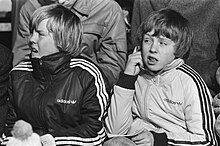
Willem-Alexander Claus George Ferdinand was born on 27 April 1967 in the University Medical Center in Utrecht, Netherlands. He was the first child of Princess Beatrix and Prince Claus, and the first grandchild of Queen Juliana and Prince Bernhard. He was the first male Dutch royal baby since the birth of Prince Alexander in 1851, and the first immediate male heir since Alexander's death in 1884.
From birth, Willem-Alexander has held the titles Prince of the Netherlands (Template:Lang-nl), Prince of Orange-Nassau (Dutch: Prins van Oranje-Nassau), and Jonkheer of Amsberg (Dutch: Jonkheer van Amsberg). He was baptised as a member of the Dutch Reformed Church on 2 September 1967 in Saint Jacob's Church in The Hague. His godparents are Prince Bernhard of Lippe-Biesterfeld, Gösta Freiin von dem Bussche-Haddenhausen, Ferdinand von Bismarck, former Prime Minister Jelle Zijlstra, jonkvrouw Renée Röell, and Queen Margrethe II of Denmark.
He had two younger brothers: Prince Friso of Orange-Nassau, (1968-2013), and Prince Constantijn of the Netherlands, born in 1969. He lived with his family at the castle Drakensteyn in the hamlet Lage Vuursche near Baarn from his birth until 1981, when they moved to the larger palace Huis ten Bosch in The Hague. His mother Beatrix became Queen of the Netherlands in 1980, after his grandmother Juliana abdicated. He then received the title of Prince of Orange as heir apparent to the throne of the Kingdom of the Netherlands.
Willem-Alexander attended Nieuwe Baarnse Elementary School in Baarn from 1973 to 1979. He went to three different secondary schools: the Baarns Lyceum in Baarn from 1979 to 1981, the Eerste Vrijzinnig Christelijk Lyceum in The Hague from 1981 to 1983, and the United World College of the Atlantic in Wales near Llantwit Major (1983 to 1985), where the prince had friends, and from which he received his International Baccalaureate.
After his military service from 1985 to 1987, Willem-Alexander studied history at Leiden University from 1987 onwards and received his MA degree (doctorandus) in 1993. His final thesis was on the Dutch response to France's decision under President Charles de Gaulle to leave NATO's integrated command structure.
Willem-Alexander speaks English, Spanish and German in addition to his native Dutch.
Military training and career
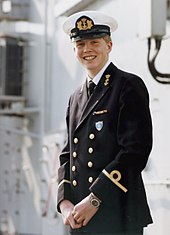
Between secondary school and his academic education, Willem-Alexander performed military service in the Royal Netherlands Navy from August 1985 until January 1987. He received his training at the Royal Netherlands Naval College and the frigates HNLMS Tromp and HNLMS Abraham Crijnssen, where he was an ensign. In 1988 he received additional training at the ship HNLMS Van Kinsbergen and became a lieutenant (junior grade) (wachtofficier).
As a reservist for the Royal Netherlands Navy, Willem-Alexander was promoted to Lieutenant Commander in 1995, Commander in 1997, Captain at Sea in 2001, and Commodore in 2005. As a reservist for the Royal Netherlands Army, he was made a Major (Grenadiers' and Rifles Guard Regiment) in 1995, and was promoted to Lieutenant Colonel in 1997, Colonel in 2001, and Brigadier General in 2005. As a reservist for the Royal Netherlands Air Force, he was made Squadron Leader in 1995 and promoted to Air Commodore in 2005. As a reservist for the Royal Marechaussee, he was made Brigadier General in 2005.
Before his investiture as king, Willem-Alexander was honorably discharged from the armed forces. The government declared that the head of state cannot be a serving member of the armed forces, since the government itself holds supreme command over the armed forces. As king, Willem-Alexander may choose to wear a military uniform with royal insignia, but not with his former rank insignia.
Royal duties and social interests

Since 1985, when he became 18 years old, Willem-Alexander has been a member of the Council of State of the Netherlands. This is the highest council of the Dutch government and is chaired by the head of state (then Queen Beatrix). He attended its weekly meetings as often as possible.
King Willem-Alexander is interested in water management and sports issues. He was an honorary member of the World Commission on Water for the 21st century and patron of the Global Water Partnership, a body established by the World Bank, the UN, and the Swedish Ministry of Development. He was appointed as the Chairperson of the United Nations Secretary General's Advisory Board on Water and Sanitation on 12 December 2006.
On 10 October 2010, Willem-Alexander and Máxima went to the Netherlands Antilles' capital, Willemstad, to attend and represent his mother, the Queen, at the Antillean Dissolution ceremony.
He was a patron of the Dutch Olympic Games Committee until 1998 when he was made a member of the International Olympic Committee (IOC). After becoming King, he relinquished his membership and received the Gold Olympic Order at the 125th IOC Session. To celebrate the 100th anniversary of the 1928 Summer Olympics held in Amsterdam, he has expressed support to bid for the 2028 Summer Olympics.
He was a member of the supervisory board of De Nederlandsche Bank (the Dutch central bank), a member of the Advisory Council of ECP (the information society forum for government, business and civil society), patron of Veterans' Day and held several other patronages and posts.
Reign
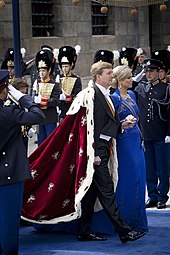
On 28 January 2013, Queen Beatrix announced that she planned to abdicate in favour of Willem-Alexander. The official programme for the abdication and investiture took place on 30 April 2013. The Queen signed the Instrument of Abdication at the Royal Palace, Amsterdam. After the abdication, Willem-Alexander was inaugurated as king on 30 April 2013. The abdication was signed at 10:07 am at the Moseszaal (Moses Hall) at the Royal Palace of Amsterdam. The Royal Inauguration, together with the United Assembly of the States General, took place at 2:30 pm at the Nieuwe Kerk.
As king, Willem-Alexander has weekly meetings with the prime minister and speaks regularly with ministers and state secretaries. He also signs all new Acts of Parliament and royal decrees. He represents the kingdom at home and abroad. At the State Opening of Parliament, he delivers the Speech from the Throne, which announces the plans of the government for the parliamentary year. The Constitution requires that the king appoint, dismiss and swear in all government ministers and state secretaries. Willem-Alexander is also the president of the Council of State, which is a historical role. The monarch seldom chairs meetings of the Council of State.
At his accession at age 46, he was Europe's youngest monarch. On the inauguration of Spain's sovereign King Felipe VI on 19 June 2014 he became, and remains, Europe's second youngest monarch. He is also the first male monarch of the Netherlands since the death of his great-great-grandfather King William III in 1890. Willem-Alexander is one of the world's four new monarchs to take the throne in 2013 along with Pope Francis of the Vatican, Emir Tamim bin Hamad of Qatar, and King Philippe of Belgium.
Leisure activities
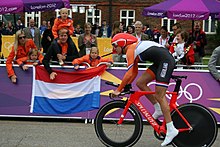
He is an aircraft pilot and sportsman. In 1989, Willem-Alexander flew as a volunteer for the African Medical Research and Education Foundation (AMREF) in Kenya, and in 1991 he spent a month flying for the Kenya Wildlife Service. To make sure he flies enough hours each year to retain his license, he occasionally flies KLM Cityhopper's Fokker 70s or the Dutch royal airplane.
Using the name "W. A. van Buren", one of the least-known titles of the House of Orange-Nassau, he participated in the 1986 Frisian Elfstedentocht, a 200 kilometres (120 mi) long ice skating tour. He ran the New York City Marathon under the same pseudonym in 1992.
Marriage and children

On 2 February 2002, he married Máxima Zorreguieta Cerruti at the Nieuwe Kerk in Amsterdam. Máxima is an Argentine woman of Basque, Portuguese and Italian ancestry, who prior to their marriage worked as an investment banker in New York City. The marriage triggered significant controversy due to the role the bride's father, Jorge Zorreguieta, had in the Argentinian military dictatorship. The couple has three daughters:
- Her Royal Highness The Princess of Orange (Catharina-Amalia Beatrix Carmen Victoria; born 7 December 2003)
- Her Royal Highness Princess Alexia Juliana Marcela Laurentien of the Netherlands (born 26 June 2005)
- Her Royal Highness Princess Ariane Wilhelmina Máxima Inés of the Netherlands (born 10 April 2007)

Privacy and the press
In an attempt to strike a balance between privacy for the royal family and availability to the press, the Netherlands Government Information Service (RVD) instituted a media code on 21 June 2005 which essentially states that:
- Photographs of the members of the royal house while performing their duties are always permitted.
- For other occasions (like holidays or vacations), the RVD will arrange a photo-op on condition that the press leave the family alone for the rest of the activity.
During a ski vacation in Argentina, several photographs were taken of the prince and his family during the private part of their holiday, including one by Associated Press staff photographer Natacha Pisarenko, in spite of the media code, and after a photo opportunity had been provided earlier. The Associated Press decided to publish some of the photos, which were subsequently republished by several Dutch media. Willem-Alexander and the RVD jointly filed suit against the Associated Press on 5 August 2009, and the trial started on 14 August at the district court in Amsterdam. On 28 August, the district court ruled in favour of the prince and RVD, citing that the royal couple has a right to privacy; that the pictures in question add nothing to any public debate; and that they are not of any particular value to society since they are not photographs of the royals "at work". Associated Press was sentenced to stop further publication of the photographs, on pain of a €1,000 fine per violation with a €50,000 maximum.
Properties
The royal family currently lives in Villa Eikenhorst on the De Horsten estate in Wassenaar. After the move of Princess Beatrix to the castle of Drakensteyn and a renovation, Willem-Alexander and his family will move to the palace of Huis ten Bosch in The Hague.
Willem-Alexander has a villa in Kranidi, Greece. His neighbour is good friend and actor Sean Connery, with whom he shares a helicopter platform.
The villa in Manchagulo
On 10 July 2008, the then-Prince of Orange and Princess Maxima announced that they had invested in a development project on the Mozambican peninsula of Machangulo. The development project was aimed at building an ecologically responsible vacation resort, including a hotel and several luxury vacation houses for investors. The project was to invest heavily in the local economy of the peninsula (building schools and a local clinic) with an eye both towards responsible sustainability and maintaining a local staff. After contacting Mozambican president Armando Guebuza to verify that the Mozambican government had no objections, the couple decided to invest in two villas. In 2009, controversy erupted in parliament and the press about the project and the prince's involvement. Politician Alexander Pechtold questioned the morality of building such a resort in a poor country like Mozambique. After public and parliamentary controversy the royal couple announced that they decided to sell the property in Machangulo once their house was completed. In January 2012, it was confirmed that the villa had been sold.
Titles, styles, honours and arms
Titles and styles
- 27 April 1967 – 30 April 1980: His Royal Highness Prince Willem-Alexander of the Netherlands
- 30 April 1980 – 30 April 2013: His Royal Highness The Prince of Orange
- 30 April 2013 – present: His Majesty The King of the Netherlands
Willem-Alexander's full style from birth until his mother's accession was: "His Royal Highness Prince Willem-Alexander of the Netherlands, Prince of Orange-Nassau, Jonkheer van Amsberg". On his mother's accession, it became: "His Royal Highness The Prince of Orange, Prince of the Netherlands, Prince of Orange-Nassau, Jonkheer van Amsberg".
Following his accession, Willem-Alexander's official title, as appearing in preambles, is: "Willem-Alexander, by the Grace of God, King of the Netherlands, Prince of Orange-Nassau, etc. etc. etc."
He was the first male heir apparent to the Dutch throne since Prince Alexander, son of King William III, who died in 1884. Prince Willem-Alexander had earlier indicated that when he would become king, he would take the name William IV, but it was announced on 28 January 2013 that his regnal name would be Willem-Alexander.
Military ranks
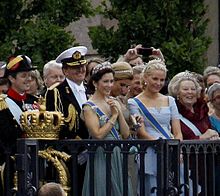
- Royal Netherlands Navy – Conscription
- Ensign (August 1985 – January 1987)
- Lieutenant (junior grade) (watch officer, 1988)
- Royal Netherlands Navy – Reserve
- Lieutenant (1988–1995)
- Lieutenant Commander (1995–1997)
- Commander (1997–2001)
- Captain at Sea (2001–2005)
- Commodore (2005–2013)
- Royal Netherlands Air Force – Reserve
- Squadron Leader (1995–2005)
- Air Commodore (2005–2013)
- Royal Netherlands Army – Reserve
- Major, Grenadiers' and Rifles Guard Regiment (1995–1997)
- Lieutenant Colonel (1997–2001)
- Colonel (2001–2005)
- Brigadier General (2005–2013)
- Royal Marechaussee – Reserve
- Brigadier General (2005–2013)
Honours
See also List of honours of the Dutch Royal Family by country
Dutch orders and decorations
In his capacity as the Sovereign, Willem-Alexander is Grand Master of the Military Order of William (Militaire Willemsorde) and the other Dutch orders of merit.
 Grand Master of the Military William Order (30 April 2013)
Grand Master of the Military William Order (30 April 2013) Grand Master and Knight Grand Cross of the Order of the Netherlands Lion (Grand Master 30 April 2013; Kt. Grand Cross 27 April 1985)
Grand Master and Knight Grand Cross of the Order of the Netherlands Lion (Grand Master 30 April 2013; Kt. Grand Cross 27 April 1985) Grand Master of the Order of Orange-Nassau (30 April 2013)
Grand Master of the Order of Orange-Nassau (30 April 2013) Co-Grand Master and Knight of the Order of the Gold Lion of the House of Nassau (Co-Grand Master 30 April 2013; Kt. 30 April 1980)
Co-Grand Master and Knight of the Order of the Gold Lion of the House of Nassau (Co-Grand Master 30 April 2013; Kt. 30 April 1980) Grand Cross of the Order of the House of Orange (27 April 1967)
Grand Cross of the Order of the House of Orange (27 April 1967) Officer's cross for long service, with numeral XXV (6 December 2011)
Officer's cross for long service, with numeral XXV (6 December 2011) Queen Beatrix Investiture Medal (30 April 1980)
Queen Beatrix Investiture Medal (30 April 1980) Royal Wedding Medal 2002 (2 February 2002)
Royal Wedding Medal 2002 (2 February 2002) King Willem-Alexander Investiture Medal (30 April 2013)
King Willem-Alexander Investiture Medal (30 April 2013) Knight of the Order of Saint John in the Netherlands (8 June 1996)
Knight of the Order of Saint John in the Netherlands (8 June 1996) Cross Elfstedentocht (26 February 1986)
Cross Elfstedentocht (26 February 1986)
Foreign orders
| Grand Cross of the Order of the Crown (before 1993) | ||
| Grand Cross of the Order of the Southern Cross (2003) | ||
| Senior (Dato Laila Utama) of the Most Esteemed Family Order of Brunei (DK I, 21 January 2013) | ||
| Grand Cross of the Order of the Merit of Chile (2003) | ||
| Knight of the Order of the Elephant (31 January 1998) | ||
| Grand Cross of the National Order of the Legion of Honour (20 January 2014) | ||
| Grand Cross of the National Order of Merit | ||
| Grand Cross 1st Class of the Order of Merit of the Federal Republic of Germany | ||
| Grand Cross of the Order of Mahaputera | ||
| Gold Olympic Order (8 September 2013) | ||
| Grand Cordon of the Order of the Chrysanthemum | ||
| Collar of the Order of the Chrysanthemum (24 October 2014) | ||
| Grand Cross of the Order of Adolphe of Nassau | ||
| Grand Cross of the Order of the Oak Crown | ||
| Band of the Order of the Aztec Eagle (2 November 2009) | ||
| Grand Cross of the Royal Norwegian Order of St. Olav (1996) | ||
| Supreme Class of the Order of the Renaissance of Oman (10 January 2012) | ||
| Knight of the Order of the White Eagle (24 June 2014) | ||
| Knight Grand Cross of the Order of Isabella the Catholic (19 October 2001) | ||
| Knight of the Royal Order of the Seraphim (RSerafO, 2006) | ||
| Knight Grand Cross (Special Class) of the Order of Chula Chom Klao (2004) | ||
| Member of the Union Order (9 January 2012) | ||
| Grand Cordon of the Order of the Liberator (2006) |
Honorary appointment
- Aide-de-camp to Her Majesty The Queen (until 2013)
Arms
Main article: Coat of Arms of the Netherlands
|
|
Ancestry
Through his father, a member of the House of Amsberg, he is descended from families of the lower German nobility, and through his mother, from several royal German/Dutch families such as the House of Lippe, Mecklenburg-Schwerin, the House of Orange-Nassau, Waldeck and Pyrmont, and the House of Hohenzollern. He is descended from the first King of the Netherlands, William I of the Netherlands, who was also a ruler in Luxembourg and several German states, and all subsequent Dutch monarchs. By his mother, Willem-Alexander also descended from Paul I of Russia and thus from German princess Catherine the Great. Through his father, he is also descended from several Dutch/Flemish families who left the Low Countries during Spanish rule, such as the Berenbergs. His paternal great-great-grandfather Gabriel von Amsberg (1822–1895), a Major-General of Mecklenburg, was recognized as noble as late as 1891, the family having adopted the "von" in 1795.
King Willem-Alexander is a multiple descendant of Anne, Princess Royal and Princess of Orange, eldest daughter of British King George II. Under the British Act of Settlement, King Willem-Alexander temporarily forfeited his (distant) succession rights to the throne of the United Kingdom by marrying a Roman Catholic. This right has since been restored
References
- "Dutch Crown Prince quits IOC in preparation to become king", Sports Illustrated, 2013, retrieved 19 April 2013.
- "Prins Willem-Alexander neemt afscheid van Adviescommissie Water", de Volkskrant (in Dutch), 2013, retrieved 19 April 2013.
- Who We Are, United Nations Secretary-General's Advisory Board on Water and Sanitation. Retrieved 19 April 2013.
- Template:Nl iconWillem-Alexander neemt afscheid als 'waterprins', Trouw, 2013. Retrieved 19 April 2013.
- ^ The Prince of Orange. Dutch Royal House. Retrieved 19 July 2009.
- Doop Willem-Alexander. Nederlandse Omroep Stichting. Retrieved 13 December 2009.
- ^ 40 meest gestelde vragen. Dutch Royal House. Retrieved 13 December 2009.
- Doopplechtigheid Prins Willem-Alexander in Sint Jacobskerk. Radio Netherlands Worldwide. Retrieved 13 December 2009.
- ^ Z.M. koning Willem-Alexander , koning der Nederlanden, prins van Oranje-Nassau, Parlement. Retrieved 5 April 2013.
- "Prins Willem-Alexander blundert tijdens staatsbezoek Mexico". 925. 5 November 2009. Retrieved 3 May 2013.
- Military career. Dutch Royal House. Retrieved 17 December 2009.
- King will retain close relationship with armed forces (press release), Ministry of Defense, 2013. Retrieved 3 March 2013
- The Dutch Council of State, De Raad van State. Retrieved 24 July 2013.
- King Willem-Alexander: Preparing for the role of monarch, Koninklijk Huis. Retrieved 24 July 2013.
- "About UNSGAB". UNSGAB. Retrieved 28 January 2013.
- ^ "New Dutch King awarded Olympic gold order, receiving IOC's highest honor after stepping down". washingtonpost.com. 8 September 2013. Retrieved 10 September 2013.
- Netherlands May Bid For 2028 Games, Gamesbids
- His Majesty King Willem-Alexander, Koninklijk Huis. Retrieved 24 July 2013.
- "Time and place of abdication and investiture". Royal Dutch House. 28 January 2013.
- Template:Nl icon Troonswisseling in Nederland (2013), Dutch Misplaced Pages, 2 May 2013
- Position and role as head of state, Koninklijk Huis. Retrieved on 2013-7-24.
- "FAQ – Dutch royalty". Radio Netherlands Worldwide. Retrieved 28 January 2013.
- Han (4 October 2012). "FAQ: eleven facts about the Eleven Cities Race | Radio Netherlands Worldwide". Radio Netherlands Worldwide. Retrieved 28 January 2013.
- Brooks, James (19 April 2013). "Dutch abdication: Ten things you never knew about the royal family of the Netherlands - Telegraph". The Daily Telegraph. Retrieved 4 May 2013.
- "Media Code on protecting the privacy of members of the Royal House". Netherlands Government Information Service. 21 June 2005. Retrieved 11 June 2010.
- "Royals sue Associated Press over holiday photos". NRC. 5 August 2005. Retrieved 11 June 2010.
- "Willem-Alexander wint rechtszaak tegen AP" (in Dutch). 28 August 2009.
- (Dutch) Verhuizing Prinses Beatrix, Koninklijk Huis. Retrieved 24 July 2013.
- "Dutch prince buys villa next to James Bond actor". M.bbc.co.uk. 16 April 2012. Retrieved 24 July 2013.
- "Willem-Alexander wil huis voor kust Mozambique" (in Dutch). Trouw.nl. 10 July 2008. Retrieved 23 January 2015.
- Bruno Waterfield (13 June 2010). "Dutch Crown Prince Willem-Alexander accused over Mozambique villa". The Daily Telegraph. London. Retrieved 13 June 2010.
- ^ "Prins had contact met president Mozambique" (in Dutch). Algemeen Dagblad. 19 November 2009. Retrieved 23 January 2015.
- "Crown prince bows to public pressure over Mozambique villa". NRC. 23 November 2009. Retrieved 11 June 2010.
- "Prins verkoopt villa in Mozambique" (in Dutch). Nos.nl. 18 January 2012. Retrieved 23 January 2015.
- Interview with Paul Witteman, September 1997, Racchvs
- Prince of Orange to become King Willem-Alexander
- Belga Pictures, group photo
- King Baudouin's funerals (08/1993), Willem-Alexander on third row
- Noblesse et Royautés (French), State visit of Netherlands in Brunei (01/2013), Photo
- Koning krijgt grootkruis van Legioen van Eer - website De Telegraaf
- Foreign honours recipients 2014 - website of the Ministry of Foreign Affairs of Japan
- The royal forums, State visit of Luxembourg to Netherlands, 2006, Photo
- Official decree
- His Majesty receives Queen Beatrix – website of the Oman Observer
- Boletín Oficial del Estado
- 3rd Photo of this gallery shows the Prince wearing the order
- H.H Sheikh Khalifa welcomes HM Queen Beatrix of Netherlands – website of the UAE Ministry of Foreign Affairs
- "Dutch Royal House – Coat of Arms and standard". Archived from the original on 21 June 2008. Retrieved 29 June 2008.
- The Coat of Arms, Vol. 9, 66–72, p. 112, Heraldry Society
- F. J. J. Tebbe, W. D. E. Aerts, Arnout van Cruyningen, Jean Klare (eds.), Encyclopedie van het Koninklijk Huis, p. 17, Winkler Prins, 2005
- http://nos.nl/artikel/2027224-willem-alexander-maakt-nu-kans-op-de-britse-troon.html
External links
- His Majesty King Willem-Alexander, biography on the official website of the Dutch Royal House
| Willem-Alexander of the Netherlands House of Orange-NassauBorn: 27 April 1967 | ||
| Regnal titles | ||
|---|---|---|
| Preceded byBeatrix | King of the Netherlands 2013–present |
Incumbent Heir apparent: Catharina-Amalia |
| Dutch royalty | ||
| VacantTitle last held byAlexander | Prince of Orange 1980–2013 |
Succeeded byCatharina-Amalia |
| Willem-Alexander of the Netherlands | ||
|---|---|---|
| Born (1967-04-27) 27 April 1967 (age 57) | ||
| Monarchies |
|  |
| Reign | ||
| Ancestry | ||
| Family |
| |
| Monarchs of the Netherlands | ||
|---|---|---|
| Kingdom of Holland (1806–1810) |  | |
| Kingdom of the Netherlands (1815–present) | ||
| 1. See also the Sovereign Principality of the United Netherlands (1813–1815) and the United Kingdom of the Netherlands (1815–1839). | ||
| Prince or Princess of Orange | ||
|---|---|---|
|  | |
| Dutch princes | |
|---|---|
| Generations indicate descent from William I, the first king of the Netherlands. | |
| 1st generation | |
| 2nd generation | |
| 3rd generation | |
| 4th generation | |
| 5th generation | |
| 6th generation | |
| 7th generation | |
| title granted by Royal Decree to consort of the Queen, without the title "Prince of Orange-Nassau"
gave up the title "Prince of the Netherlands, but still held the title "Prince of Orange-Nassau" title granted by Royal Decree to descendants of Princess Irene only held the title "Prince of Orange-Nassau" | |
| Current monarchs of sovereign states | |
|---|---|
| Africa | |
| Asia | |
| Europe | |
| Americas | |
| Oceania | |
| |
| Heads of state of the European Union member states | |
|---|---|
| Council of State of the Netherlands | ||
|---|---|---|
| President |  | |
| Vice-President | ||
| Members | ||
| Advisory Members | ||
| Extraordinary Members | ||
| Ex officio Members | ||
- Use dmy dates from May 2013
- 1967 births
- Dutch people of German descent
- Dutch monarchs
- Dutch royalty
- House of Amsberg
- House of Orange-Nassau
- International Olympic Committee members
- Leiden University alumni
- Living people
- Members of the Council of State (Netherlands)
- People educated at Atlantic College
- People from Utrecht (city)
- People from Wassenaar
- Protestant Church Christians from the Netherlands
- Protestant monarchs
- Presidents of the Council of State (Netherlands)
- Princes of Orange
- Bands of the Order of the Aztec Eagle
- Grand Croix of the Ordre national du Mérite
- Grand Crosses of the Order of Adolphe of Nassau
- Grand Crosses of the Order of Merit (Chile)
- Grand Crosses of the Order of Merit of the Federal Republic of Germany
- Grand Cordons of the Order of the Chrysanthemum
- Grand Crosses of the Order of the Crown (Belgium)
- Grand Cordons of the Order of the Liberator
- Grand Crosses of the Order of the Southern Cross
- Grand Crosses of the Order of the Oak Crown
- Knights Grand Cross of the Order of Chula Chom Klao
- Knights Grand Cross of the Order of Isabella the Catholic
- Knights Grand Cross of the Order of St. Olav
- Knights of the Order of the Gold Lion of the House of Nassau
- Special Classes of the Order of the Renaissance of Oman
- Grand Masters of the Order of Orange-Nassau
- Grand Masters of the Order of the House of Orange
- Grand Masters of the Order of the Netherlands Lion

